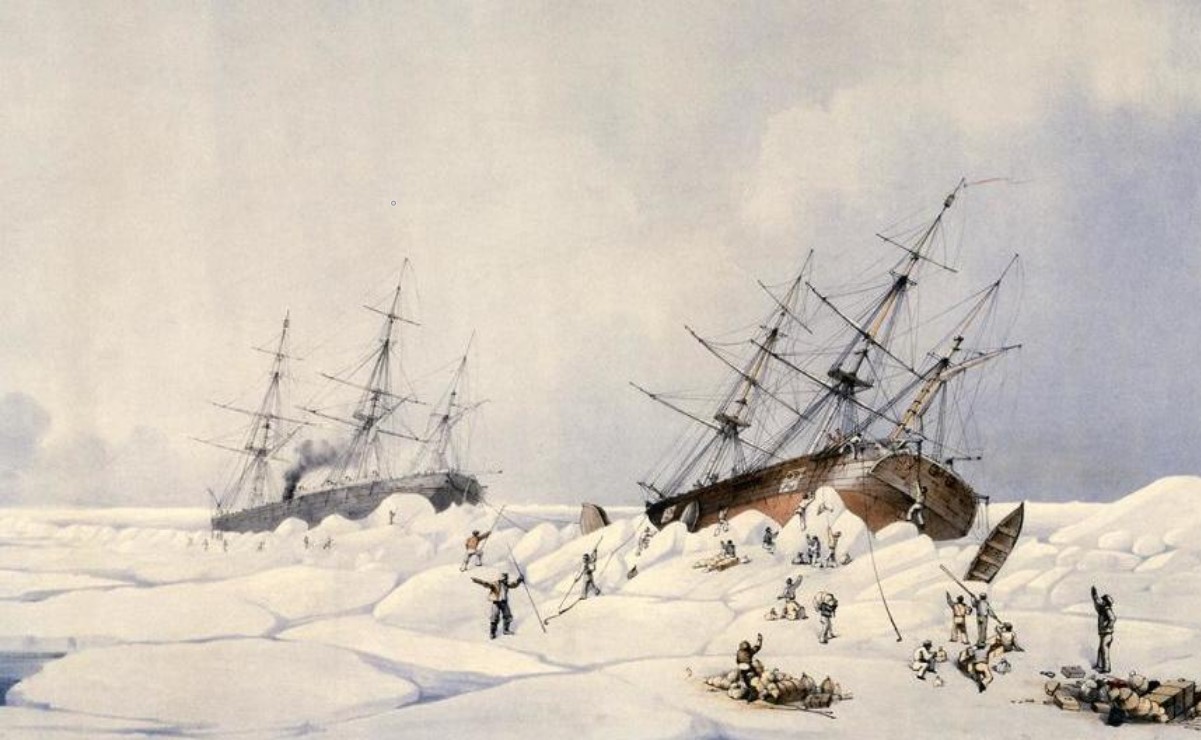
HMS Breadalbane (right) and the HMS Phoenix off Beechey Island, Nunavut. [Edward Augustus Inglefield]
A national historic site and possibly the best-preserved wreck on Earth, the vessel sank 170 years ago today.
“Breadalbane is unique among shipwrecks,” Joe MacInnis, a physician-scientist who discovered the wreckage back in 1980, wrote in The Canadian Encyclopedia. “Some of the cargo and working tools and personal effects of the crew are still on board.”
The 40 metre-long, 500 ton vessel was built near Glasgow, Scotland, along the Clyde River in 1843 by the Hedderwick and Rankin firm. A typical build for its era, the three-masted barque was made of woods from around the world.
Designed for transportation, not speed, the merchant ship was a globe trotter, carrying wine and wool among other goods to some of Europe’s most high-traffic ports. Travelling as far as Calcutta, or present-day Kolkata, India, one surveyor observed: “The barque is eligible for the safe conveyance of dry and perishable cargos to and from all parts of the World.”

Map of the probable routes taken by HMS Erebus and HMS Terror during Franklin’s lost expedition. [Wikimedia]
“Breadalbane is unique among shipwrecks. Some of the cargo and working tools and personal effects of the crew are still on board.”
But the Breadalbane was called to a higher purpose following the failed Franklin expedition of 1845.
Aboard ships HMS Erebus and HMS Terror, Captain John Franklin and his crew looked to sail the Northwest Passage to find a shortcut to the Asia. Still, it appears they underestimated the treacherous Canadian Arctic.
“Polar pack ice was hard as rock, sharp as a knife, unforgiving and indiscriminate,” wrote Susan McLeod in a post to the Glimpses of Canadian History website.
Setting off on May 19, 1845, as one of the largest and best-equipped expeditions England had ever sent to the polar region, Franklin and his crew ultimately met disaster. All 134 men died. The ships reportedly trapped in Arctic ice for years.
Of course, the expedition’s fate was not known at the time, so numerous searches where undertaken in hopes of finding signs of the enterprise. In 1853, the Royal Navy called the Breadalbane to action, tasking the ship with carrying supplies to Edward Belcher’s search party. Under the command of Admiral Edward Augustus Inglefield, Breadalbane set out on a dangerous mission, ordered to return “without a moment’s delay.”
But even with a seasoned crew and sturdy hull, the Canadian Arctic was merciless. Just before midnight on Aug. 21, 1853, Breadalbane’s starboard bow was punctured by a slab of ice.
As the ship sunk about a kilometre south of Beechey Island in the Barrow Strait, its 21-men crew clambered overboard and onto its companion ship, HMS Phoenix.
“From the time the first nip took her, until her disappearance, did not occupy more than fifteen minutes,” one crew member related.
Saved by the skin of their teeth against the blistering tides, all men aboard survived, leaving Breadalbane mummified in the cold Arctic waters. More than 100 years later, MacInnis led an expedition to find the wreck.

HMS Breadalbane underwater. [Operation Nunavut/Flickr]
HMS Breadalbane remains a scientific wonder of the natural world.
MacInnis and his team would have to try more than once to slip beneath the unforgiving waters, searching in 1978 and 1979 with little success.
“In the Arctic, everything is something to overcome,” MacInnis told The New York Times in 1982.
Making use of eyewitness accounts and research by Arctic marine historians Stuart Hodgson and Maurice Haycock, MacInnis conducted a third search in 1980 and succeeded. Breadalbane’s fractured bowsprit was pointing eastward, toward home in England.
In 2014, the Canadian Armed Forces and Parks Canada joined forces to capture high-resolution images and video of the wreck, allowing all to explore some of Breadalbane’s treasures.
Known as the ship to have toppled at the top of the world, far above the Arctic Circle, HMS Breadalbane remains a scientific wonder of the natural world.
“Diving down to her,” MacInnis wrote, “studying her remains, is an excursion into Canada’s past and into our future.”
Advertisement





















